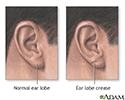Earlobe creases
Earlobe creases are lines in the surface of earlobe of a child or young adult. The surface is otherwise smooth.
Considerations
The earlobes of children and young adults are normally smooth. Creases are sometimes linked with conditions that are passed down through families. Other genetic factors, such as race and earlobe shape, may also determine who develops earlobe creasing and when it occurs.
It is not uncommon to have one small abnormality in facial features, such as an earlobe crease. Most often, this does not indicate a serious medical condition.
Causes
In children, earlobe creases are sometimes linked with rare disorders. One of these is Beckwith-Wiedemann syndrome .
Beckwith-Wiedemann syndrome
Beckwith-Wiedemann syndrome is a growth disorder that causes large body size, large organs, and other symptoms. It is a congenital condition, which ...

When to Contact a Medical Professional
In most cases, the health care provider will notice earlobe creases during a regular checkup.
Talk to your provider if you are concerned that your child's earlobe creases may be linked to an inherited disorder.
What to Expect at Your Office Visit
The provider will examine your child and ask questions about medical history and symptoms. These may include:
- When did you first notice the earlobe creases?
- What other symptoms or problems have you also noticed?
Tests depend on the symptoms.
References
Evans K, Hing AV, Cunningham M. Craniofacial malformations. In: Gleason CA, Devaskar SU, eds. Avery's Diseases of the Newborn . 9th ed. Philadelphia, PA: Elsevier Saunders; 2012:chap 95.
Ludman MD. Assessing congintal anomalies. In: Goldbloom RB, ed. Pediatric Clinical Skills . 4th ed. Philadelphia, PA: Elsevier Saunders; 2011:chap 5.
-
Ear lobe crease - illustration
The earlobe in children and young adults is normally smooth. Creases are seldom seen, but when present, they are sometimes associated with rare inherited syndromes.
Ear lobe crease
illustration
Review Date: 12/9/2016
Reviewed By: Neil K. Kaneshiro, MD, MHA, Clinical Assistant Professor of Pediatrics, University of Washington School of Medicine, Seattle, WA. Also reviewed by David Zieve, MD, MHA, Medical Director, Brenda Conaway, Editorial Director, and the A.D.A.M. Editorial team.

